Namba Station in Osaka: 6 Train Lines, Map, and Navigation Tips

Namba, located in the center of Osaka, has six stations all named "Namba". Use this guide to navigate all six stations easily and reach the major Osaka sightseeing spots nearby.
Namba Station: Convenient for Osaka Sightseeing
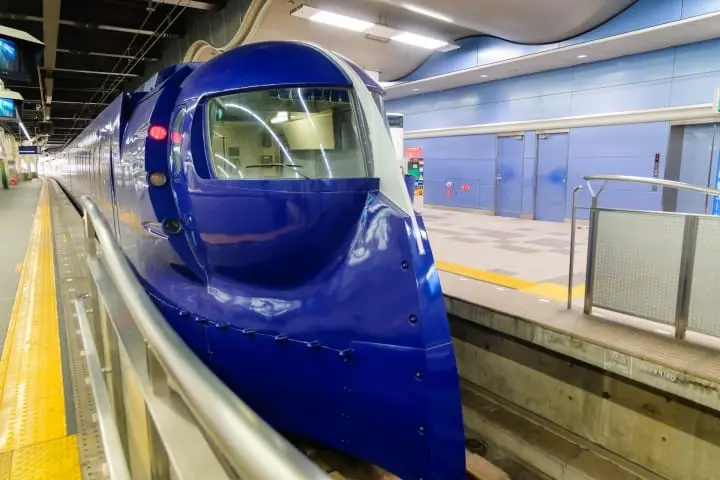
The Limited Express Train Connecting Namba Station and Kansai International Airport is called rapi:t
Namba, in southern Osaka, is a major station near popular spots like Dotonbori and Shinsaibashi. It also offers fast, 35-minute access to Kansai International Airport (KIX) via the rapi:t train, making it a convenient base for exploring Osaka.
However, Namba is home to six train stations with nearly identical names across various JR, private, and Osaka Metro lines, causing significant confusion for both locals and travelers. This article will clarify the differences, explain navigation, and guide you to sightseeing areas from each station.
On the official website of Kintetsu Railway, you can find a map of Namba Station.
The Six Namba Stations
| Lines and Station Names | Major Attractions Nearby |
| 1. Nankai Namba Station | Kansai International Airport (KIX), Mt. Koya |
| 2. Kintetsu Line and Hanshin Line Osaka Namba Station | Tsutenkaku Tower, Shinsekai, Umeda (JR Osaka Station), Shin Osaka |
| 3. Midosuji Line Namba Station (Osaka Metro) | Nara, Universal Studios Japan (USJ) |
| 4. Yotsubashi Line Namba Station (Osaka Metro) | Nara, Horyuji |
| 5. Sennichimae Line Namba Station (Osaka Metro) | Americamura |
| 6. JR Line Namba Station | Nipponbashi, Tsuruhashi |
These are the six Namba Stations. Nankai Namba Station is the only one aboveground, while the others are all underground.
Read also
How to Navigate Around the Namba Stations
Use Nankai Namba as the Starting Point
Nankai Namba Station is housed in a giant station building. When entering the station from aboveground, it can be a great starting point as it is difficult to miss. JR Namba Station and Namba Station on the Yotsubashi Line are about five to ten minutes away on foot. The others are roughly in the same place. If you follow at the signs while moving forward, you shouldn’t get too mixed up.
Use the Name of the Line to Ask for Directions
Since all of the stations are named Namba Station, focus on the name of the specific line you need to take. If you want to get assistance, ask an employee: “Where’s the Nankai Line?” or “Where’s the Midosuji Line?” to get the directions you need.
Next, let’s take a look at spots that are easily accessible from each station!
1. Nankai Namba Station - Easy Access to Kansai International Airport and Mt. Koya

The Nankai Namba Station is the only Namba Station at street level. This large combined building is home to the station, the Takashimaya department store and various shops.
The rapi:t limited express train runs from Nankai Namba Station and arrives at KIX without any need for transfer, making it very convenient for visitors. You can also reach Mt. Koya by train from here.

Let us explain how to get to the ticket gates at the Nankai Namba Station. Enter the building and go through the first floor to the escalator, pictured above. There are ticket gates on the 2nd floor and 3rd floor. The platforms bound for KIX and Mt. Koya are both on the 3rd floor. Take the escalator on the right, which will take you directly to the 3rd floor.

This is the Nankai Line ticket gate. The ticket counter and information booth are pictured on the left.

The language setting on the ticket machine can be changed to English, Chinese or Korean.
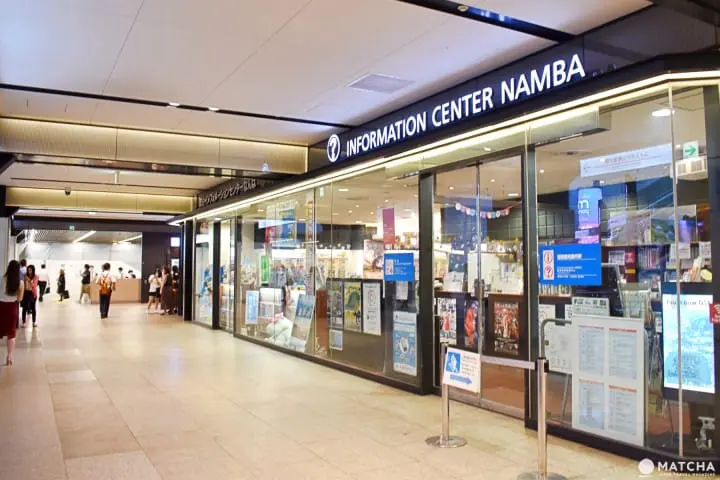
If you are not sure about something you can ask for help at the tourist information center next to the escalator on the 1st floor.
Access to KIX
The limited express from KIX to Nankai Namba Station takes about 45 minutes (920 yen), and the rapi:t about 40 minutes (1,430 yen).
We suggest purchasing tickets online via Klook, which has one-way and round-trip options.
The Nankai homepage also offers discounts on tickets for the rapi:t, so we recommend checking before you buy the tickets at the station.
Access to Mt. Koya
Take the “Limited Express Koya” from Nankai Namba Station and get off at Gokurakubashi Station (90 minutes, 2,040 yen). From there, you can take the cable car to Mt. Koya.
2. Kintetsu and Hanshin Osaka Namba Station - Travel to Universal Studios Japan and Nara

Both the Kintetsu line and the Hanshin line run through Osaka Namba Station. They are different lines but occupy the same station. Take the Kintetsu line to get to Nara, and the Hanshin line to head towards Hyogo.

The Kintetsu and Hanshin ticket counters. Note that each line sells its own tickets
Osaka Namba Station provides easy access to Nara via the Kintetsu line, and to USJ (Universal Studios Japan) and Kobe via the Hanshin line.
To get to Universal Studios Japan, take the Hanshin line to Universal City Station. You’ll need to transfer once to the Yumesaki Line. On that same train, you can get to Kobe-Sannomiya Station located in the center of Kobe without making any transfers. To get to Nara, take the Kintetsu line to Kintetsu-Nara Station. You won’t need to make any transfers.
Access to USJ (Hanshin Line)
Transfer at Nishi-Kujo Station to the Yumesaki Line and get off the train at Universal City Station. You will get there in about 25 minutes (260 yen).
Access to Kobe (Hanshin Line)
Get off the train at Kobe-Sannomiya Station. It will take about 45 minutes on the rapid train (410 yen) and there is no need to transfer.
Access to Nara (Kintetsu Line)
Exit the train at Kintetsu-Nara Station. You don't need to transfer and will get there in 45 minutes (410 yen).
Osaka Metro - Platform for the Midosuji Line, the Yotsubashi Line and the Sennichimae Line

The Midosuji Line, the Yotsubashi Line, and the Sennichimae Line are all part of the Osaka Metro subway system. The subway lines are connected inside the station, so you can switch lines without exiting the ticket gate. The Osaka Metro lines are all color-coded. As seen in the picture above, the station guide denotes each line by encircling the first letter of the line with its color.
The Midosuji Line (M) is reded, the Yotsubashi Line (Y) is Blue and the Sennichimae Line (S) is Pink.
3. Midosuji Line Namba Station: Umeda, Shin-Osaka, Tsutenkaku

The Midosuji Line is very easy to use. The Osaka hub of Umeda Station, the Shinkansen stop at Shin-Osaka Station and Dobutsuenmae Station by Tsutenkaku are all stations on the Midosuji line. You can also walk one station over to Shinsaibashi Station (about 15 minutes on foot). There are several street-level entrances around Nankai Namba Station. You just have to go down the stairs to access the subway. There are station guides at each entrance, you can use them for reference.
Getting to Shinsekai (Dobutsuenmae Station)
No transfers needed, the travel time is about five minutes (180 yen).
Getting to Umeda Station
No transfers needed, the travel time is about 10 minutes (230 yen).
Getting to Shin Osaka Station
No transfers needed, the travel time is about 15 minutes (280 yen).
4. Yotsubashi Line Namba Station - Go Shopping in Americamura

Yotsubashi Namba Station is a bit farther away from the other subway stations. It’s located on the way to JR Namba Station and five minutes on foot from Nankai Namba Station. Yotsubashi Station, only one station from Yotsubashi Namba Station, is the closest station to the fashion haven Americamura. The line is marked with a Y inside a blue circle.
Getting to Americamura (Yotsubashi Station)
No transfers and it takes only one minute by train (180 yen).
5. Sennichimae Line Namba Station: Let's Go to Nipponbashi and Tsuruhashi (Korean Town)

The Sennichimae Line stops at Nipponbashi station. The is the closest access point to the Osaka's electronics district Nipponbashi. It also stops at Tsuruhashi Station, which is where Koreatown and a concentration of yakiniku (grilled meat) restaurants are located. The line is marked with an S inside a pink circle.
Access to Nipponbashi
No transfers and the travel time is only one minute (180 yen).
Access to Tsuruhashi
No transfers and the travel time is about five minutes (180 yen).
6. JR Namba Station - Visit Nara or Get to the Highway Bus Terminal

JR Namba Station is located in a different place than the other Namba stations. You can access the World Heritage site Horyuji via Horyuji Station, as well as Nara Station and other famous spots using this line.
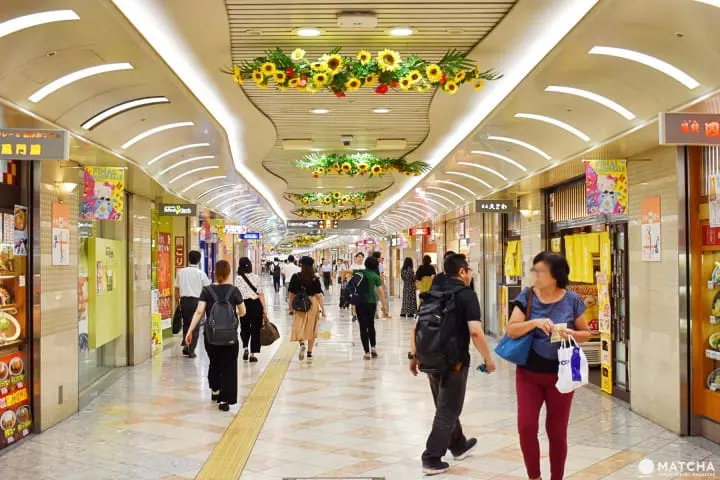
JR Namba Station can be accessed from aboveground, but getting there this way is complicated. We recommend accessing it via the underground corridors instead. From Nankai Namba Station, it’s about five to ten minutes on foot.
As you head toward JR Namba Station through the underground shopping arcades, you will eventually enter the Namba WALK (pictured above), lined by restaurants and shops on both sides. You might wonder, “Is this really the right way to the JR?”. Yes, it is! Just keep going.

Once you see the moving walkway, JR Namba Station is right ahead.
Getting to Horyuji Station
Take the Yamatoji Line rapid train and get off at Horyuji Station. You will travel for about 35 minutes (460 yen).
Getting to Nara
Take the Yamatoji Line rapid train and get off at Nara Station. Travel time is about 45 minutes ( 560 yen)
The JR Namba Building Also Houses the Highway Bus Terminal

The bus terminal, known as OCAT, can be entered through this building.
OCAT, located on the 2nd floor of JR Namba Station, is the highway bus terminal. Limousine buses to KIX and Osaka International Airport, as well as highway buses to destinations all over Japan, depart and arrive here.

It can be difficult to find. Enter the building and you’ll see an escalator, but don’t get on. Go along the left-hand path in the photo and get on that escalator instead. Go up and you will see the arrival and departure area on the 2nd floor.
FAQ
Is Namba Station and Osaka Namba Station the same?
Namba Station and Osaka Namba Station are two distinct yet closely situated train stations in Osaka, Japan, serving the bustling Namba district. Namba Station primarily functions as a terminal station for the Nankai Railway lines, connecting Osaka with destinations such as Kansai International Airport and southern Osaka Prefecture, while also providing access to popular tourist areas like Dotonbori. On the other hand, Osaka Namba Station, managed by JR West and Kintetsu Railway, serves as a major transportation hub for JR trains on the Yamatoji Line and Kintetsu lines, offering connections to various destinations within Osaka and beyond. Both stations are essential for navigating Osaka and reaching nearby regions, providing convenient access to key attractions and facilitating travel throughout the city and beyond.
Can I use a Suica card in Osaka?
While the Suica card is a convenient and widely used IC card primarily associated with the JR East railway network in the Tokyo metropolitan area and certain other regions in Japan, you cannot directly use a Suica card in Osaka. In Osaka and the Kansai region, the dominant IC card used for transportation is called ICOCA, which is interchangeable with Suica and other major IC cards like PASMO and PiTaPa.
If you have a Suica card and plan to travel to Osaka, you can use it for transportation there by making use of the "IC Card Through Ticket" service, which allows you to travel across different regions in Japan using your Suica card. This service enables seamless travel by transferring the balance from your Suica card to an ICOCA card, which is compatible with the transportation system in Osaka and the Kansai region. Through this process, you can enjoy the convenience of using your Suica card for transportation in Osaka and other parts of Japan that accept IC cards.
Is there Shinkansen at Namba station?
Namba Station in Osaka does not have Shinkansen services. The Shinkansen, also known as the bullet train, is a high-speed rail network in Japan operated by JR (Japan Railways) that connects major cities across the country. In Osaka, the primary Shinkansen station is Shin-Osaka Station, which serves as a major hub for Shinkansen services in the region. From Shin-Osaka Station, you can access Shinkansen trains to various destinations such as Tokyo, Kyoto, Hiroshima, and other major cities throughout Japan.
Namba Station, on the other hand, mainly serves as a terminal for local and regional train services in the Namba area, including the Nankai Railway lines and connections to other local railways. While Namba Station does not have Shinkansen services, travelers can easily reach Shin-Osaka Station from Namba via local trains or the Osaka Metro to access the Shinkansen network for high-speed travel throughout Japan.
Which exit is Namba Station from Dotonbori?
To access Dotonbori from Namba Station in Osaka, travelers have several exit options depending on their desired destinations within the bustling district. The Midosuji Line Exit (Exit 14) is ideal for direct access to the heart of Dotonbori, including prominent attractions like the Glico Running Man sign and the Dotonbori Canal. Utilizing the Nankai Line Exit through the Namba Walk underground shopping arcade offers a convenient pathway toward Dotonbori, particularly beneficial during adverse weather conditions. For those arriving via the Yotsubashi Line of the Osaka Metro, exits near Dotonbori provide proximity to popular landmarks such as Ebisubashi Bridge and the Tonbori River Walk. By selecting the appropriate exit at Namba Station, visitors can easily navigate to Dotonbori and immerse themselves in the vibrant atmosphere and diverse offerings of this renowned entertainment and shopping district in Osaka.
Is Namba a good area in Osaka?
Namba in Osaka stands out as a dynamic and bustling area, revered for its diverse attractions and vibrant atmosphere that appeal to visitors seeking an authentic Osaka experience. Boasting an array of shopping options ranging from modern malls to traditional shopping streets, Namba caters to a wide range of tastes and preferences. The district's lively entertainment scene, epitomized by the iconic Dotonbori district with its neon lights and culinary delights, offers a plethora of dining, nightlife, and cultural experiences. Namba's rich culinary landscape, including local specialties like takoyaki and okonomiyaki, makes it a paradise for food enthusiasts. Home to cultural gems such as Hozenji Temple and Kuromon Ichiba Market, Namba also provides insights into Osaka's history and traditional market culture. Its status as a transportation hub further enhances its appeal, enabling convenient access to other parts of Osaka and beyond. In essence, Namba emerges as a top choice for travelers looking to immerse themselves in the vibrant essence of Osaka's culture, cuisine, and urban charm.
Is it better to stay in Namba or Umeda?
Deciding between staying in Namba or Umeda in Osaka hinges on individual preferences and the desired experience while in the city. Namba, characterized by its vibrant atmosphere, lively entertainment districts like Dotonbori, diverse shopping options, and culinary delights, caters to visitors seeking a bustling urban experience with a mix of culture and nightlife. In contrast, Umeda offers a more modern cityscape replete with sleek skyscrapers, upscale shopping venues like Grand Front Osaka, and convenient transport links for exploring Osaka and beyond. The district's emphasis on contemporary attractions, cultural venues, and accessibility via various train lines makes it an appealing choice for those who prioritize convenience and a cosmopolitan setting. Ultimately, the decision to stay in Namba or Umeda depends on one's preferences for atmosphere, activities, and the overall vibe desired for their Osaka experience.
Plenty of Places to Visit Around Namba Station
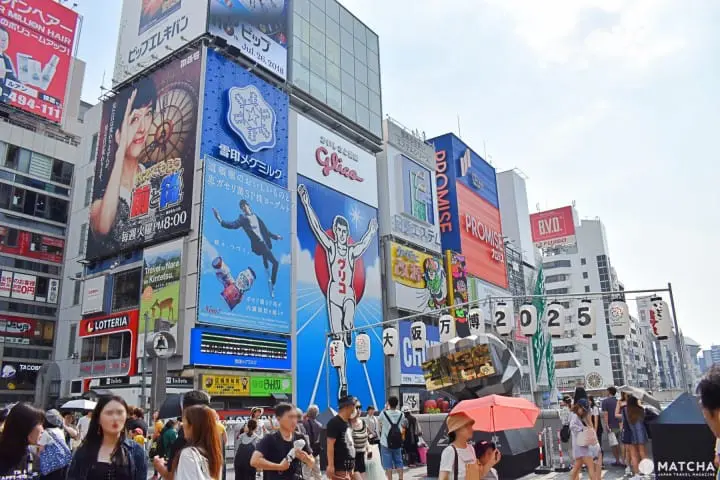
Dotonbori
There is a concentration of popular sightseeing and shopping spots around Namba Station. Shinsaibashi and Dotonbori are only five to ten minutes away on foot. Shinsekai and Tsutenkaku are five minutes away on the Midosuji line. You can easily find Osaka’s famous kushikatsu (grilled meat and vegetables on a skewer), takoyaki and other famous Osaka dishes at the restaurants around Namba station.
If you keep the points in the article in mind, you should be able to navigate your way through Namba Station more efficiently and comfortably. In addition to this article, we have also created a guide to the all-access public transportation passes in Kansai, which will surely be useful when traveling to and in Osaka. Enjoy your trip!
Read also
This is the official account of MATCHA's editorial department. Our articles feature useful travel information for visitors to Japan, from how-to guides to recommended places to visit.













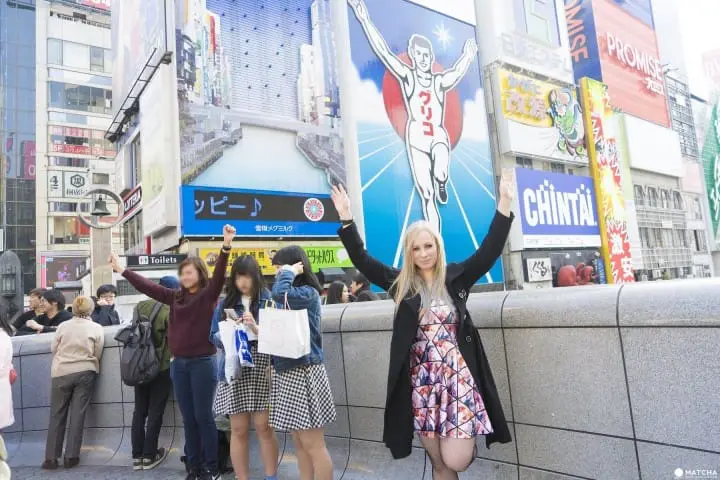



























![[Reopening in March 2026] Ikoma Sanjo Amusement Park Park, 45 minutes from Osaka , with free admission](https://resources.matcha-jp.com/resize/720x2000/2024/08/28-194409.webp)
![[Gunma] 5 recommended gourmet foods at Kawaba Denen Plaza Roadside Station!](https://resources.matcha-jp.com/resize/720x2000/2025/02/26-225970.webp)
![[Kanazawa] Enjoy the world of gold leaf to the fullest in the city with the highest production volume in Japan](https://resources.matcha-jp.com/resize/720x2000/2025/11/12-249564.webp)
![[2026] Family Winter Trip to Suzuka Circuit! – For Both Day trips and Overnight Stays!](https://resources.matcha-jp.com/resize/720x2000/2025/12/26-254097.webp)
